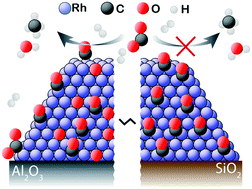Structure–function relationship during CO2 methanation over Rh/Al2O3 and Rh/SiO2 catalysts under atmospheric pressure conditions†
Abstract
The effect of the support material and chemical state of Rh in Rh/A2O3 and Rh/SiO2 model catalysts during CO2 hydrogenation were studied by a combined array of in situ characterisation techniques including diffuse reflectance infrared Fourier transform spectroscopy, energy-dispersive X-ray absorption spectroscopy and high-energy X-ray diffraction at 250–350 °C and atmospheric pressure. CO2 methanation proceeds via intermediate formation of adsorbed CO species on metallic Rh, likely followed by their hydrogenation to methane. The linearly-bonded CO species is suggested to be a more active precursor in the hydrogenation compared to the bridge-bonded species, which seems to be related to particle size effects: for larger particles mainly the formation of inactive bridge-bonded CO species takes place. Further, analysis of the chemical state of Rh under the reaction conditions reveal a minor formation of RhOx from dissociation of CO2, which is a consequence of the increased activity observed over the Rh/Al2O3 catalyst.



 Please wait while we load your content...
Please wait while we load your content...